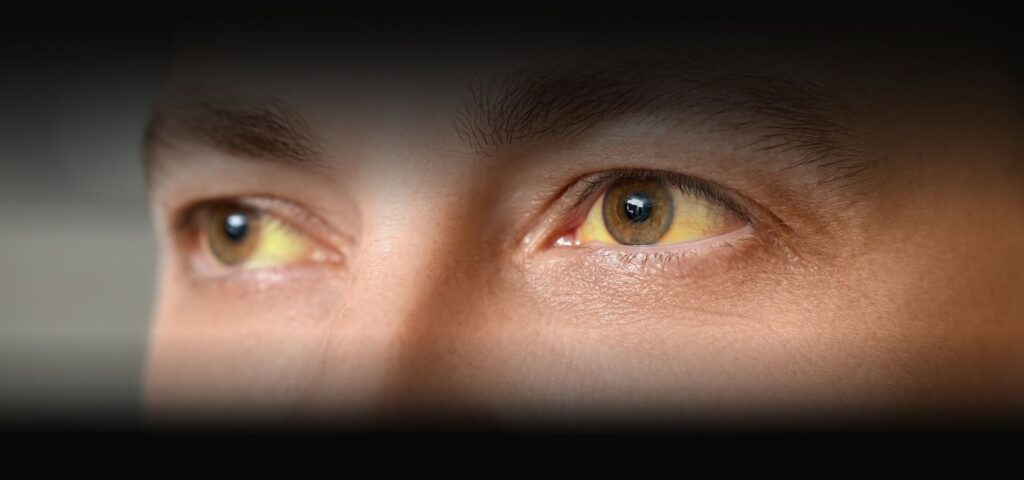What are Alcoholic Eyes and its Symptoms

House Of Zen > Blogs > What are Alcoholic Eyes CALL US (844) 717-7069 Understanding Alcoholic Eyes and Their Symptoms Drinking alcohol might affect your eyesight, among other things. Knowing the symptoms of the eyes can be beneficial for those with alcohol use disorders to determine the consequences of binge drinking. This comprehensive guide will review the signs, how drinking impairs vision, and the symptoms to look out for. What Are Alcoholic Eyes? The term “alcoholic eyes” indicates a distinctive look of the eyes that frequently comes on by long-term alcohol consumption. These are not only visual alterations; they may also be a sign of more severe health problems associated with drinking. Knowing what signs of eyes appear like might provide crucial information about a person’s drinking patterns and general health. What Factor Play Role In Eye Toxification? An excess of alcohol can lead to intoxication. The amount of alcohol required to develop intoxication might differ significantly from person to person depending on:• Person body size • Alcohol type • Dehydration level • lethargy • Carbonated beverage intake • Gender • Number of meals they consume • Medication or other drugs • Mood swings • Tolerance level How Does Alcohol Affect a Person’s Vision? Drinking alcohol affects vision in several ways, changing the way the eyes look and operate. The following are some of the effects of heavy drinking on the eyes, including long-term symptoms. Excessive drinking could: • Increased retinal degeneration associated with aging • Raise the prevalence of diabetic retinopathy despite conflicting data • Related to central retinal vein occlusion • Enhance the chance of developing central serous chorioretinopathy • Cause dietary optic neuropathy • Red eyes after alcohol (redness and irritation) • Having a connection to glaucoma, despite contradicting data • Raise the chance of cataracts due to aging These connections might factor in several potential issues or consequences for the eyes. Does Drinking Cause Bloodshot Eyes? Yes, bloodshot eyes can result from alcohol use. Alcohol dehydrates the body, which makes the inflamed blood vessels in the eyes more noticeable. Although this impact is generally transient, consuming too much alcohol might make it worse. Drinking in moderation is defined by the National Institute on Alcohol Abuse and Alcoholism (NIAAA) as having no more than two drinks for men and one drink for women each day. How To Prevent Getting Alcoholic Eyes You may be suffering from Alcohol Use Disorder (AUD) and would like to prevent these vision issues. If so, you should get advice from professionals. An effective treatment program can provide you with the encouragement and guidance you need to conquer your AUD. The following elements will be part of the program: Assessment You will meet with the medical staff before beginning the recovery program. The physician will be asking many questions throughout this meeting. These will be related to your drinking history, including the length of time and volume of alcohol you have consumed. Your medical and mental health histories will also be examined. They can determine if you have a mild, moderate, or severe case of AUD based on the information you provide. This might direct the detox procedures and aid in their estimation of the duration of your detox. Medical Detox If you suffer from moderate to severe AUD, there are some hazards related to alcohol detoxification. This is why it is never recommended for someone to try detox on their own without medical supervision. The body will remove alcohol from its system over four to five days during detox. Days 3–4 are when symptoms peak before starting to lessen. When medication is required to reduce the discomfort of the withdrawal symptoms, the detox team will provide it. Therapy After detox, you’ll be stable enough to participate in therapy. The main goal of your treatment will be to use various forms of therapy that can help you change your behavior problems as needed. To achieve this, evidence-based treatments that have been investigated and proven to be effective are used. These treatments consist of Motivational Enhancement Therapy (MET), CM (Contingency Management), DBT (Dialectical Behavior Therapy), and CBT (Cognitive Behavioral Therapy). Holistic Treatment There is a strong correlation between mental and physical wellness. In treatment, you will learn relaxation techniques, which will improve your ability to handle stress. You are free to employ these techniques during your rehabilitation since stress might lead to a relapse. Art therapy, drawing, yoga, mindfulness training, stretching, and breathing practice are some examples of holistic therapeutic techniques. Alcoholic eyes are an indication that you or a loved one needs to get treatment for AUD. The sooner alcoholism is treated, the faster the damage to the eyes will be repaired. Conclusion For anybody worried about the impact of alcohol on their health, they must identify and comprehend the signs. By being aware of symptoms like bloodshot, red, and dilated pupils, as well as impaired vision, people may address their drinking habits and proactively maintain their general health. The holistic approach to treatment is at the core of the HOZ therapy program. Restoring wellbeing is possible via this mind-body-spirit connection. Get treatment immediately to reduce the risk of developing alcoholic pupils. For any inquiries regarding the program, kindly contact us.
Misconceptions and Myths About Relapse

House Of Zen > Blogs > Misconceptions and Myths CALL US (844) 717-7069 Myth 1: Relapse Means Failure Reality: Relapse is a Part of Recovery One of the most prevalent myths about addiction is the belief that relapse indicates failure. Relapse, though, frequently occurs throughout the healing phase. Similar to addressing long-term conditions like diabetes or high blood pressure, addiction treatment might involve obstacles. It is critical to realize that recurrence is not an indication of failure but rather a need for continued therapy and support. Myth 2: Relapse Happens Suddenly Reality: Relapse is a Gradual Process Another major misperception regarding drug addiction is the idea that relapses develop suddenly. Relapse is a slow process that frequently starts far earlier than drug or alcohol usage. Emotional and mental factors are usually the first to lead to a physical relapse. Identifying the warning symptoms might help in preventive actions. Myth 3: Relapse Only Happens with Certain Drugs Reality: Any Substance Use Disorder Can Involve Relapse One prevalent misconception about drug addiction is that specific medications, such as alcohol or opioids, are the only ones that cause relapse. Relapse, however, can happen with any kind of substance use problem, including ones involving stimulants, prescription drugs, or even behavioral addictive disorders. Having an exhaustive knowledge of this fact helps develop comprehensive addiction prevention plans. Myth 4: Only Weak-Willed People Relapse Reality: Addiction is a Complex Disease One detrimental addiction myth is the belief that people with weak wills are the only ones who relapse. Addiction is a challenging disorder with genetic, environmental, and psychological aspects. Relapse signifies that prolonged treatment and support are required, not a reflection of a person’s morality or willpower. Myth 5: Codependency is a Myth Reality: Codependency is a Real Concern Some people feel that codependency is a myth. However, it is a genuine and severe problem in terms of addiction and relapse. Encouraging behaviors that might hinder recovery and prolong the addiction cycle are a sign of codependency. Codependent behaviors must be acknowledged and addressed for the benefit of the recovering person as well as their loved ones. Myth 6: Relapse is Inevitable Reality: Relapse is Preventable Relapse is common, but it is not always inevitable. The belief that relapses are an unavoidable aspect of recovery from addiction is another common misperception. Many can maintain long-term sobriety without relapsing when they are given the appropriate techniques and counseling. By identifying triggers, getting support, and continuing therapy, preventive steps can reduce the probability of recurrence. Myth 7: After a Relapse, Recovery is Impossible Reality: Recovery is Always Possible Among the most distressing is the belief that recovery from another attack is unachievable. In actuality, rehabilitation is always possible, regardless of the challenges endured. Every step toward recovery builds tolerance and resilience, raising the chance that later attempts at healing will be effective. Recurrences must be overcome with dedication, support, and appropriate therapeutic modifications. Conclusion: Dispelling Myths for Better Recovery Understanding facts underlying addiction recovery and dispelling myths are essential to developing a helpful and practical healing atmosphere. Everything you think you know about addiction is wrong. We might reduce the negative perceptions related to addiction and relapse by revealing these myths and providing more support to people on the journey toward healing.
What is Enabling a Drug Addict and How to Stop It?

House Of Zen > Blogs > What is Enabling a Drug Addict CALL US (844) 717-7069 What is Enabling a Drug Addict and How to Stop It? When it relates to addiction, many people might be unfamiliar with the word “enable.” Which usually refers to “permit” or “allow” behavior. While friends and family members of abusers typically have good intentions, their behaviors might unintentionally contribute to and sustain the addict’s harmful behavior. This article describes enabling addiction, explains how to identify it, and provides helpful advice on how to quit enabling a person with an addiction while continuing to provide support. What is Enabling Behavior? Enabling behavior is defined as any action that, consciously or subconsciously, encourages a person with an addiction to continue to consume substances. This could mean giving them money, hiding their activities, or refusing to set and enforce limits. An enabler is often a friend or family member of an addict who accepts or tolerates their addictive actions. It could be by giving money or putting up with the addict’s unacceptable behavior. Enabling vs. Helping Understanding the difference between enabling and helping is necessary. Helping involves engaging in activities that help an addict’s recovery and urge them to accept responsibility for the actions they take. Enabling, on the other hand, encourages addiction by alleviating the negative consequences that the addict would otherwise face. Signs of Enabling Behavior If you are close to someone who is addicted, you may believe that you are supporting their addiction, but in reality, you may be feeding it. It’s critical to identify these enabling actions, put an end to them, and provide the addicted user with actual support that promotes their recovery. • Avoiding the serious topic of addiction in front of addict user • Providing financial support • Taking their responsibilities and paying their bills • Blaming other close people instead of addict users • Prioritizing their needs over your own. How to Stop Enabling an Addict? Enabling, much like addiction itself, can quickly become a harmful lifestyle choice. You may find yourself becoming addicted to your loved one’s addiction, putting your own well-being and mental health at risk. You frequently feel angry and alone after enabling them. However, there are strategies for preventing and modifying this behavior. Learn About Addiction Learn about addiction to clarify misconceptions and have a deeper understanding of it. Acknowledge that only a drug addict person can choose to be fit and free of addiction. Set Clear Boundaries Developing clear boundaries can be one of the initial steps toward stopping enabling behavior. Explain these limits clearly and consistently, expressing what behaviors you will not allow and what action you will implement if those boundaries are crossed. Take Professional Help Think about consulting with an addiction therapist or counselor. They can give you guidance on how to quit being enabling and improve the way you support the addict’s rehabilitation. Encourage Responsibility Motivate the person with a substance use disorder to take responsibility for their actions. This means letting them deal with the natural impact of their actions. Instead of calling in sick for them, let them handle the consequences if, for example, they are late to work due to drug usage. Promote Rehab Efforts Encourage the addict to take on recovery and therapy. This might involve looking into available treatments, attending support groups, or providing consolation. Make sure that the things you do support their recovery rather than their dependency on drugs. Educate Yourself Learn about enabling habits and addiction. Knowing the mechanics of addiction may help you identify behaviors that promote recovery and create more effective action plans. Join Healthy Support Join support groups for people who have loved ones who are battling with addiction to get healthy support. Connecting with people going through comparable experiences might offer insight or get information from the House of Zen Recovery Rehab experts. Stop Making Excuses Give up justifying the addict’s actions and decisions. You cannot solve their issues by protecting them from the consequences of their behavior. You’re not supposed to be their caregiver. Encourage Treatment Providing your loved one with Codependency treatment is the best move you can make. It’s crucial to ask, even if they are unprepared to admit they have an issue. If they decline to help hands, firmly maintain your limits. What Happens When You Stop Enabling? It might be a challenging and traumatic process to cease enabling, but the addict needs to heal. Addicts frequently experience resistance or unpleasant reactions at first, but this is a critical step in realizing they need to change. Positive Outcomes One can get several benefits by ceasing to enable: • Better Motivation for Recovery: Addicts could be more motivated to get treatment and modify their behavior if they don’t have a shield of enabling behaviors. • Healthy Relationships: Honest, lasting relationships can result from setting clear limits. • Personal Development: Both the enabler and the addict may experience interpersonal growth and development. Challenges and Resistance When you stop enabling, it’s necessary to be ready for resistance and maybe violence. Reactions from the addict might include lying, rage, or denial. To help you negotiate these difficulties, maintain your limits firmly and ask experts or support groups for help. Addiction Impacts the Whole Family, Not Just the Addict Addiction has a significant impact on the whole family. It is not only harmful to an addict. Family members who put too much effort into caring for the addict may face hatred and disrespect. Fear, worry, and irritation are common emotions in relationships. Families must get treatment when negative relationships are occurring. Often, setting limits and restoring balance requires expert guidance. Conclusion Enabling drug addicts who are addicted to substance use to continue their addiction is a prevalent and dangerous behavior. You might help an addict in their recovery more effectively if you recognize the warning signs of enabling, establish clear limits, and promote responsibility. Giving up enabling is a complex but necessary first step in promoting a more
Telescoping and Its Effect on Men vs Women

House Of Zen > Blogs > Telescoping and Its CALL US (844) 717-7069 Telescoping and Its Effect on Men vs Women A psychological phenomenon known as telescoping describes how people feel time in a different way, making previous events seem they’re already happened recently. This impact can have significant implications for our understanding of how men and women feel and respond to different events, especially when it comes to addiction, trauma, and mental health. What is Telescoping? Telescoping is a word that describes the phenomena in which people perceive past experiences as occurring sooner than they did. This may influence memories by altering one’s personal time frame and sensation of time passing on. There are two forms of telescoping described within the definition . Forward Telescoping: People engage in forward telescoping when they recall an event as if it happened more recently than it did. For example, when someone recalls an important event—such as a wedding or graduation—as having taken place three years ago, while in reality, it happened five years ago. . Backward Telescoping: Reverse telescoping occurs when they recall an event that occurred earlier than it did. For example, when someone recalls starting their first job six years ago, it happened three years ago. What Are The Factors That Affect Telescoping? There are a few possible explanations for why some people develop dependence more quickly after their initial exposure. Among them are the following: • Co-occurring Conditions • Variations in Biology • Social Differences • Types of Gambling Understanding the Telescoping Test The telescoping test is a psychological assessment tool used to measure the degree of telescoping in individuals. This test typically involves asking participants to recall specific events and then comparing their recollections with the actual dates. This helps us understand how memory distortions differ across genders and psychological conditions. Recognizing the Signs and Seeking Help It is essential to recognize the initial signs of a rapid addiction to take action before the condition gets worse. One of the common signs is an increased tolerance to drugs. • Using larger quantities to get the same result. • Having withdrawal symptoms during limited durations of abstinence. • Red flags also include emotional signals, including mood swings, lying about drug use, and disengagement from close relationships. Telescoping Effect on Men vs Women Studies reveal that there are gender differences in effect, especially when it comes to trauma and substance abuse. Telescoping and Drug Consumption When it comes to drug use research, women often report a shorter time between first using a substance and developing a dependence than males. People call this the “telescoping-effect.” Gender-specific treatment strategies are necessary since women may develop an addiction more quickly than men do after beginning to use drugs. Telescoping and Trauma Women are typically shown to be more sensitive to stressful situations than males, which might make the telescoping worse. Their memory of devastating events may seem fresh to them, which could aggravate PTSD symptoms (Post-traumatic Stress Disorder). However, men may show less obvious telescoping in stressful situations, yet they can still be profoundly impacted by it. How Does Telescoping Affect Women Compared to Men? Telescoping, in which previous events are felt as more recent, affects men and women variably depending on their condition. Here’s a glance at how this phenomenon differs according to gender under various circumstances: Gambling In a 4,764-person Australian research, it turns out that males begin gambling at a younger age and progress toward regular and problematic gaming more swiftly than women. Another study, however, indicates that women may develop gambling problems more quickly than males. Alcoholism A Columbia University research that reviewed data from two nationwide surveys conducted ten years apart found no evidence of a significant telescoping effect in the alcohol consumption and dependency of women. Nevertheless, prior research suggests that women may transition from beginning usage to dependency more quickly. Opioid Use According to research, women use heroin less frequently than males do, and they also take it for shorter periods and with fewer injections. Prescription opioid usage rates were greater in women aged 12-17 and higher in males aged 18-25, according to data from the 2004 National Survey on Drug usage and health. Use of Stimulants Although the rates of consumption of stimulants, such as cocaine, are equal for men and women, some research indicates that women may be more susceptible to dependency because of the substances’ rewarding effects. Cannabis Consumption In the US, cannabis is the most often used illegal substance. Research indicates that males are more prone than females to consume cannabis regularly and to start using it earlier in life. However, the telescoping effect that is specific to cannabis Conclusion Telescoping is a psychological sensation that influences how we feel about the time of past events. Variations in how men and women perceive telescoping can have major implications for psychological well-being, addiction treatment, and legal cases. By being aware of and adapting these variations, professionals can develop more effective, individualized treatment and evaluation strategies.

